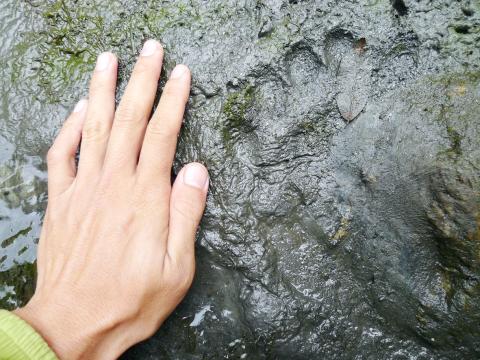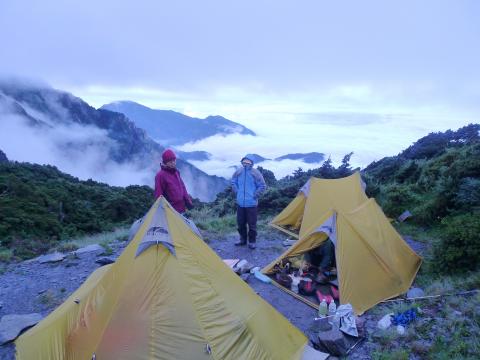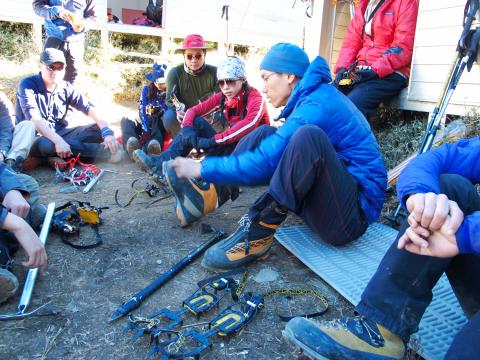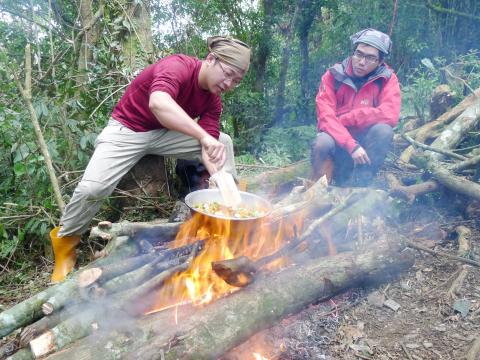People like to talk about Taiwan’s 100 peaks (百岳), a shorthand reference to the quite considerable number of mountains along Taiwan’s Central Mountain Range that exceed 3,000m in height. The 100 peaks, and the many mountain trails in the high places of the Central Mountain Range, are popular with Taiwan’s mountain climbing fraternity, but despite the wide appreciation of their scenic beauty, the physical demands of exploring these peaks mean only a very small minority of Taiwanese have ever experienced these mountains in person.
This is something that Lin Cheng-han (林政翰), a long-time mountaineer and founder of Miasan Outdoor Center (米亞桑戶外中心), wants to change. His aim is not simply to get people up into the mountains, but also to develop their understanding of a unique mountain environment. In the past, the high mountains were the preserve of Taiwan’s many trekking associations, ad hoc gatherings composed mostly of students and hearty retirees, who often, though far from exclusively, saw climbing as a test of stamina. In recent years, there has been a burgeoning growth in more commercial climbing groups in which trekking companies cater to the demands of tourists by providing convenience and comfort, but which also lack commitment to educating the public about Taiwan’s mountain environment.
Slightly over a decade ago, my own experience as a novice climber was one of bewilderment and occasional fear. Pre-trek meetings were usually half-hour briefings about the route, which to someone without map reading skills were completely incomprehensible, the handing out of a list of essential equipment that I should procure, and encouraging remarks about not worrying too much as all would be fine.

Photo Courtesy of Lin Cheng-han
This is how I found myself in running shoes, inadequate thermals, a superannuated backpack and a woeful state of physical fitness preparing to make a four-day assent of Nanhu Mountain (南湖大山) with nearly 30 others, uncertain what I had got myself into. My climbing companions were friendly and often sympathetic, but this did not altogether compensate for my lack of knowledge and proper preparation. It was not a situation that I would have wished on anyone I greatly cared for.
While the large loose groups of the trekking associations which provided my own introduction to climbing in Taiwan are still a major presence on the mountain, there are those in the mountain climbing community who are eager to change Taiwan’s climbing culture.
For Lin, the way to do this is through a mixture of old knowledge and new technology. Miasan, with its mix of educational and social center, is designed to cater to people interested in not just conquering Taiwan’s 100 peaks, but in actually getting to know the mountains. For this reason, Lin is a strong proponent not just of climbing mountains, but learning about them and the skills required to survive outdoors.

Photo Courtesy of Lin Cheng-han
“Without these skills you are never on equal terms with the mountain,” he said. “You can’t really know the mountains if you can’t survive there.”
Lin, a former rock climber competing at the national level who has also taken part in research projects on the Formosan Black Bear and Clouded Leopard, said that a seminal experience for him in appreciating and learning about Taiwan’s mountains was the long periods of time he spent working closely with Taiwan’s Aboriginal people.
“My association with Taiwan’s aborigines has had a huge influence on me,” Lin said, “It has had a profound impact on the way I teach climbers and lead climbing groups. I have spent a lot of time with Aboriginal hunters up in the mountains, and I have absorbed their style of oral transmission, which is different from a formal type of teaching… It’s kind of difficult to express, but I feel that chatting, demonstrations and interaction is a much more effective way of passing on knowledge to climbers.”

Photo Courtesy of Lin Cheng-han
Lin’s association with Taiwan’s Aborigines has also led him to include a course titled Aboriginal Hunting School, in which he turns back the clock and teaches climbers basic skills that constitute an important part of an Aboriginal hunters knowledge. It includes everything from making an impromptu shelter to basic tracking.
“This knowledge allows climbers to appreciate the mountain environment in a more intimate fashion. Most climbers at most will look at the scenery, but there is plenty more to see: the marks and tracks of various animals and insects. Often, even if they notice them, they can’t identify them,” he said. “Taiwan does not actually have many mountains that require advanced technical skills [to climb],” Lin said. “Climbing here is more about appreciating a new environment, so I have designed a number of activities to make the most of this.”
Although mountain climbing has grown in popularity in Taiwan, Lin does not believe that either knowledge or respect of the mountains is trickling down to the wider public.

Photo Courtesy of Lin Cheng-han
“I don’t think there has been much change in the culture of mountain climbing in Taiwan,” Lin said. “There are an increasing number of small groups, but another trend over the last 10 years has been the increase in purely commercial climbing groups… Climbing has become a form of tourism… There is nothing inherently wrong with such groups, but often, in catering to their customers, travel companies ignore some environmental details, such as dumping kitchen waste on the mountain. They are also disinclined to correct or instruct their paying customers about proper behavior on the mountain, so people do not learn the best way to interact with this environment.”
Whether climbing associations or travel companies, large groups remain the norm, and there is inevitably an impact on the environment and on safety. “Many commercial companies have a 1:10 or 1:12 ratio of guides to climbers, and when many of these are inexperienced, this has safety repercussions,” Lin said.
“One of the features of climbs with Miasan is that the groups themselves are quite small, but we get a lot of repeat customers. There are some who [have learned enough] that they don’t really need to take part in the classes, but they sign up for new courses anyway.”
Lin emphasizes the use of modern equipment that allows climbers to travel relatively light, or which reduce the physical impact of climbing — the use of climbing sticks and head straps — lowering the entry level of physical fitness required for novices, as well as instruction in simple techniques, such as correct breathing and walking style. With smaller groups and programs that emphasize specific learning goals, Lin believes that he is able to provide something more to the exploration of Taiwan’s mountain environment.
Miasan, with its wide variety of classes ranging from easy treks for beginners to mountain survival skills for more seasoned climbers, seeks to reveal different aspects of Taiwan’s mountain environment, and open up a seam in Taiwan’s mountain climbing culture in which knowledge and observation are as important as climbing prowess.
More information about Miasan Outdoor Center can be found at www.miasan.com.

April 14 to April 20 In March 1947, Sising Katadrepan urged the government to drop the “high mountain people” (高山族) designation for Indigenous Taiwanese and refer to them as “Taiwan people” (台灣族). He considered the term derogatory, arguing that it made them sound like animals. The Taiwan Provincial Government agreed to stop using the term, stating that Indigenous Taiwanese suffered all sorts of discrimination and oppression under the Japanese and were forced to live in the mountains as outsiders to society. Now, under the new regime, they would be seen as equals, thus they should be henceforth

Last week, the the National Immigration Agency (NIA) told the legislature that more than 10,000 naturalized Taiwanese citizens from the People’s Republic of China (PRC) risked having their citizenship revoked if they failed to provide proof that they had renounced their Chinese household registration within the next three months. Renunciation is required under the Act Governing Relations Between the People of the Taiwan Area and the Mainland Area (臺灣地區與大陸地區人民關係條例), as amended in 2004, though it was only a legal requirement after 2000. Prior to that, it had been only an administrative requirement since the Nationality Act (國籍法) was established in

With over 80 works on display, this is Louise Bourgeois’ first solo show in Taiwan. Visitors are invited to traverse her world of love and hate, vengeance and acceptance, trauma and reconciliation. Dominating the entrance, the nine-foot-tall Crouching Spider (2003) greets visitors. The creature looms behind the glass facade, symbolic protector and gatekeeper to the intimate journey ahead. Bourgeois, best known for her giant spider sculptures, is one of the most influential artist of the twentieth century. Blending vulnerability and defiance through themes of sexuality, trauma and identity, her work reshaped the landscape of contemporary art with fearless honesty. “People are influenced by

The remains of this Japanese-era trail designed to protect the camphor industry make for a scenic day-hike, a fascinating overnight hike or a challenging multi-day adventure Maolin District (茂林) in Kaohsiung is well known for beautiful roadside scenery, waterfalls, the annual butterfly migration and indigenous culture. A lesser known but worthwhile destination here lies along the very top of the valley: the Liugui Security Path (六龜警備道). This relic of the Japanese era once isolated the Maolin valley from the outside world but now serves to draw tourists in. The path originally ran for about 50km, but not all of this trail is still easily walkable. The nicest section for a simple day hike is the heavily trafficked southern section above Maolin and Wanshan (萬山) villages. Remains of